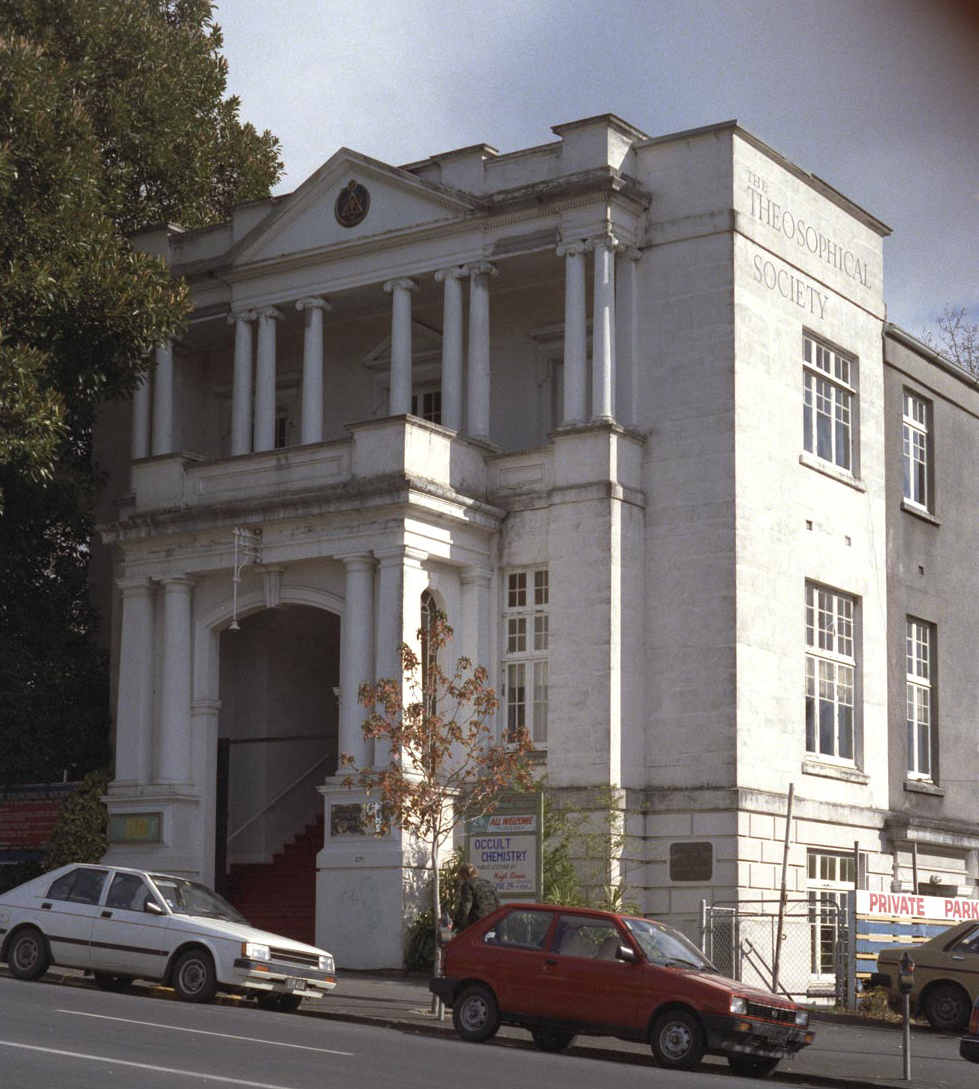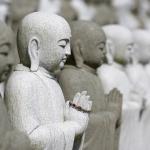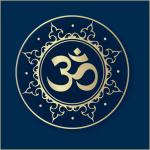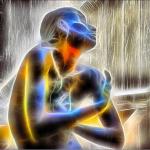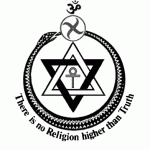The History of Theosophy in Auckland
The History of Theosophy in Auckland
by Jack Patterson
Note: This article confines itself to the history of the Auckland lodge and the H.P.B. Lodge. The New Zealand Section Headquarters has always been in Auckland, but as its Centenary will be celebrated in 1996 it will be referred to only as necessary to complete the histories of the Lodges.
The First Members in New Zealand
The birth of Theosophy in New Zealand did not take place in Auckland, although this city has always been the centre of the Theosophical Society in this country. Mr Augustine Les Edgar King was the first New Zealand member, having joined when on a visit to London. His Diploma is dated 3rd April 1879 and on his return to New Zealand he became the first member of the Society in the Southern Hemisphere.
Mr Thomas G de Remzy of Dunedin joined in January 1883 and at the end of that year Mr & Mrs James Cox became members in Auckland. Col. Olcott writing of Mr Cox says: “He had such a reputation as a psychometrist principally by the way of distinguishing disease that he made a good living by practicing the profession, constantly going between Auckland and Sydney to see his patients.” Mr E.T. Sturdy whom Col. Olcott referred to as the “Father of Theosophy in New Zealand”, joined the Society in 1885 while living at Woodville in Hawkes Bay. After travelling overseas and meeting Col. Olcott, H.P. Blavatsky and W.Q. Judge he returned to New Zealand and settled in Wellington. Gathering a group of students around him he started the Wellington Lodge which was chartered in 1888. Unfortunately this, the first lodge in New Zealand, ceased to exist when Mr Sturdy returned to England, where he became a student in H.P.B.’s “inner group”.
Theosophy in Auckland
The birth of Theosophy in Auckland really happened when in the six months between September 1891 and March 1892 sixteen persons joined the Society. Among them were Mr W.H. Draffin, Samuel Stuart, Margaret Lilian Edger and Dr Charles W. Sanders, all of whom were destined to play important roles in the future work of the Society. Mr Draffin was headmaster of one of the Public Schools of Auckland and Mrs Draffin is mentioned by Col. Olcott in 0Id Diary Leaves as “having suddenly blossomed out as an eloquent platform speaker after having passed through a very severe illness.” Mr Stuart was a keen student of Mathematics, Astronomy and Astrology but was unable to accept the more esoteric aspects of Theosophy. Miss Edger M.A. (Hons) was one of the first women in the British Empire to gain a University Degree. Four years later she became the first General secretary of the N.Z. Section but enticed by Col. Olcott, who recognised her outstanding ability as a lecturer, she soon departed overseas. Dr Sanders, a practising homoeopath, became General Secretary after Miss Edger and held that office for twenty-one years. He was a born propagandist and had a large private correspondence throughout New Zealand.
Auckland Lodge is Chartered
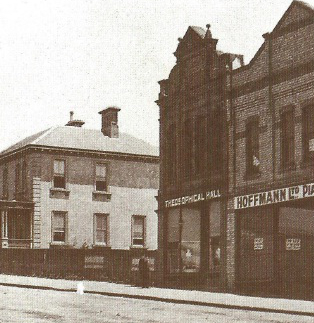
This group of enthusiastic Auckland members soon formed the Auckland Lodge, the Charter of which is dated 24th March 1892.
The Auckland Lodge elected Mr Draffin as their first President. They may have occupied their own rooms earlier but it is recorded that in 1896 the Auckland Lodge was sharing rooms with the newly-formed New Zealand Section on the second floor of the Mutual Life Building in Lower Queen Street.
These premises, which included a small lecture hall and several other rooms were, even in those days, open the greater part of every day with the daily lunch table part of the activities. A study class met every Tuesday. Regular Sunday lectures were held in a large barn-like hall in Lower Symonds Street in which the 500 available seats were usually well filled. In those days, there was no transport available on Sundays and as nearly all the members of the Lodge lived two or three miles from the hall, attendance at these meetings meant about an hour’s walk each way up and down several long hills.
In 1896, because one more Lodge was needed to form the New Zealand Section, some Auckland members formed the Waitemata Lodge on the North Shore, which lasted only about a year. However, the Onehunga Lodge, founded in 1904, lasted until 1929 due to the efforts of two keen members, Melville Newton and J.H. Simpson who were both scholarly lecturers.
The Community House, Ponsonby Road
The Hemus family home in Ponsonby Road was a centre of Theosophical activity for about 35 years. It seems that meetings were held here as well as in the city. Miss Geraldine Hemus writing about the early days of the Theosophical Society in Auckland in the 1946 Jubilee number of Theosopby in New Zealand describes this community house and a photograph of it is reproduced. Miss Hemus writes ”My mother (Mrs G.E. Hemus) and her two sisters, Miss L. Edger and Mrs M. Judson all joined the Society in the early nineties and became enthusiastic workers. About 1893 Miss Edger acquired the property. Mr Draffin, then President of the Auckland Branch and his wife went to live there with her and many Theosophical gatherings were held in the spacious rooms.” For a time it was leased for a Boys School but in 1898, after failure to sell the property, the Hemus family moved back in and were joined by Mr. Frank Davidson (the Assistant General Secretary) and some other members, making it again a community house. It was in this house that Mrs. Besant and other overseas visitors were accommodated.
Overseas Visitors
It must seem amazing to us today that so many distinguished visitors braved the stormy Tasman Sea and the rigours of travel in this young country to visit the newly formed Lodges. Of course they all spent time in Auckland. Firstly Mrs. Cooper-Oakley came in 1893 and Mrs. Besant was in Auckland the following year staying in the bedroom with the dormer-window in the Ponsonby house. Miss Hemus says she was then at the heyday of her oratorical power and gave some wonderful lectures to packed audiences in the old Albert Street Hall. The Countess Wachmeister came in 1895-6 and in 1897 Colonel Olcott spent about a fortnight in Auckland. At this time the ministers of various churches in Auckland by branding Theosophy ‘Anti-Christian’, gave it publicity and many of the public came to meetings to hear what it was all about. When Colonel Olcott spoke on ‘Healing and Spiritualism’, 1000 people crowded into the hall and in the press report of the meeting he was called a “genial, well-educated and cultured gentleman”!
H.P.B. Lodge Chartered
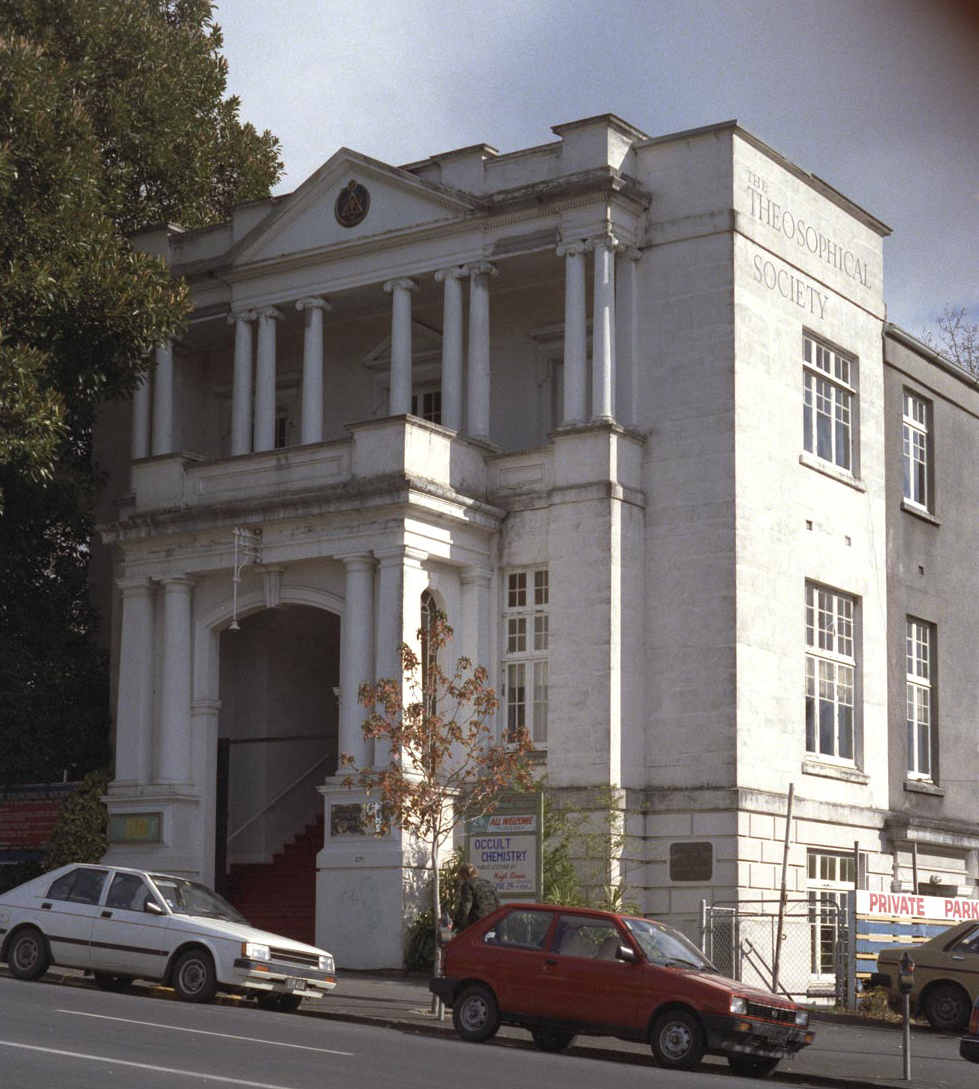
HPB Lodge in Queen Street
Towards the end of 1902, trouble arose between members of the Auckland Lodge which could not be resolved and several members, including Dr. Sanders and the Draffins seceded and formed a new Lodge which was chartered under the name ‘H.P.B.’ on 11th February 1903. Mr. Sam Stuart remained with the Auckland Lodge but its membership dwindled, and its Charter was handed back in July 1924. The H.P.B. Lodge took rooms first in the Strand Arcade and then in His Majesty’s Arcade. The Section moved in early 1906 to the City Chambers where a fire occurred in June causing the loss of many records. After that, the Section and H.P.B. Lodge both moved to 351 Queen Street where they occupied the whole building, even setting up a printing press in the basement. To improve the slum conditions around 351 Queen Street the members used meditation and concentrated thought. This appears to have had some effect because shortly afterwards, Myers Park was developed. Both H.P.B. Lodge and the Section remained there until they moved into the present building at 371 Queen Street, which was opened in 1923.
Outstanding New Workers
In 1904, John Ross Thomson and William Crawford came to Auckland. They were then two very Scotch young men whose speech was often difficult to understand, but they were fired with enthusiasm for Theosophy. Mr Thomson, who was later known affectionately as ‘J.R.T.’, had been a socialist and spiritualist in England but after meeting Annie Besant joined the Theosophical Society. Shortly after arriving in New Zealand in 1902, he met William Crawford at a meeting of the Wellington Lodge. They became firm friends and worked together for the rest of their lives. J.R.T. was a born leader of men with a rare understanding of human nature and a magnetic personality which attracted young members. He had the gift of expressing theosophical concepts with great clarity, and his closing remarks as Chairman often made a deeper impression on the audience than the lecture had done. He could also be forceful. Harry Banks, who worked closely with him, told the story of how J.R.T., at a Convention, won a heated verbal battle with Sam Stuart who could not accept the aim of living a spiritual life under the guidance of the Masters which energised the whole of J.R.T.’S life.
Mr. Thomson became President of H.P.B. Lodge in the third year of its existence (1905) and was re-elected to that office right up to 1933 when his health began to fail. He was also General Secretary from 1918 to 1925, when Mr. Crawford took that office which he filled for fourteen years. Two other life-long workers for the Lodge, Miss Nettie Ockenden and Mrs Esther Turner, also joined in 1904.
Growth in the Early Years
In 1905 C.W. Leadbeater spent a fortnight in Auckland taking five combined meetings of the Auckland and H.P.B. Lodges which attracted audiences of nearly 100. Two very inspiring lecturers Miss Kate Browning M.A. and Miss Catherine Christie, both from Dunedin, gave a series of Sunday evening lectures in Auckland to large audiences. In 1908 Annie Besant drew audiences of 1000 to her two lectures, and when C.W. Leadbeater came again in 1914 and 1915, his public lectures attracted equally large audiences. With so much strength and inspiration flowing into the Lodge, its membership, which had been 70 in 1905, grew to 280 in 1915. When Miss Christie was in Auckland that year she lectured to audiences of 250 every Sunday in one of the Public Theatres, and in 1918, for nine consecutive months, she lectured in the concert chamber of the Town Hall every Sunday. H.P.B. membership reached 400! The Lodge had been incorporated in 1915 and title taken for a possible site in Greys Avenue for a building. In December 1921 the Lodge sold this site at a good profit and acquired for 4,000 pounds the section at 371 Queen Street. Plans were prepared by Mr. Robinson, an English architect who had joined the Society. A tender of 9,982 pounds was accepted and on 16th December 1922 the Lodge President, J.R. Thomson, laid the foundation stone. Nine months later, the formal opening and consecration of the building took place.
Soon after the opening of the building, Miss Clara Codd and Professor Ernest Wood lectured from its platform and C. Jinarajadasa visited in 1925, Dr. G.S. Arundale and Rukmini in 1930 and L.W. Rogers from America in 1932. During the recession of the thirties, many members resigned but the Lodge managed to meet its financial obligations. In 1933 failing health caused Mr. Thomson to give up the Presidency thus terminating 29 years as teacher, guide and leader. Mr. Geoffrey Trevithick was elected President and filled that Office with efficiency and harmony until 1948 when he declined nomination. In 1934 when Krishnamurti talked at H.P.B. Lodge many of his supporters stormed up on the platform with him.
A great impetus to theosophical work in New Zealand and especially in Auckland, was given by Geoffrey Hodson who arrived in December 1940 to be Guest Speaker at the Christchurch Convention. He made Auckland his headquarters and stayed in New Zealand for an unbroken ten years. As National Lecturer he visited all the Lodges but gave the largest share of his time to H.P.B. Lodge which benefited tremendously. His lectures even when extended to a series over several weeks, attracted at least 100 members and public. He still helped H.P.B. Lodge when he returned from overseas to his New Zealand home at 17 Belvedere Street, but in later years the frequency of his lectures was reduced. His last lecture to an audience which filled the hall was given at H.P.B. Lodge on 4th May 1982 on the Subject ‘Kundalini-Shanti – its use in Occult Research’. This is a very remarkable achievement for one who at the time was ninety-six years of age. He died in Auckland early in the next year.
Many of his books were written in Auckland and one, Theosophy Answers Some Problems of Life actually came from his answers to questions from the audience in H.P.B. Lodge. Several H.P.B. Lodge members helped him in research, provided illustrations for his books and typed or edited material. But most of his work was carried out by Sandra Hodson (nee Chase) who as Geoffrey’s wife and Secretary worked unceasingly, especially in the last few years of his life, to help him complete the books he was writing. She published, after his death, The Light of the Sanctuary in which many diary notes cover his life in Auckland.
H.P.B. Lodge in Recent Years
The Golden Jubilee Convention of the New Zealand Section was held in H.P.B. Lodge in 1946 with N.Sri Ram representing the International President. It was a record gathering, and the photograph taken at the time in Myers Park shows nearly two hundred members. Miss Emma Hunt who was general Secretary at this time produced the Golden Jubilee number of Theosophy in New Zealand (April-June 1946) in which she carefully recorded the history of all theosophical activity in New Zealand. The International President. C. Jinarajadasa visited again in 1951, attracting large audiences to H.P.B. Lodge and inspiring many with his presence. The work of the Lodge was stimulated in the following years by visits by N.Sri Ram when he was President and by the later Presidents John Coats and Radha Burnier. Two international lecturers Joy Mills and Ianthe Hoskins have more recently, not only lectured, but held instructive seminars at H.P.B. Lodge. In 1949 when Geoffrey Trevithick stood down as H.P.B. President, the Lodge elected a younger member, Jack Patterson, to that position and two years later another young member, Milton Thornton, became President. Limiting the office to two years meant that many members have had the opportunity of being President of H.P.B. Lodge, some for more than one term but none for a long consecutive period. The membership was now again on the increase and soon exceeded 500, making it one of the largest Theosophical Lodges in the world. In 1948, the New Zealand Section offices were moved from the H.P.B. Lodge building to 10 Belvedere Street, Epsom. The Liberal Catholic Church and the Co-Masonic movement both subsequently moved to their own premises. This did not really diminish the activity in the building which was still in use several nights a week with the Library and Book Shop being open daily. In 1992, the year which marked the centenary of Theosophy in Auckland, the H.P.B. Lodge, whose President was Arthur Goodall, had a membership of 504.
Other Theosophical Activities in Auckland
In 1918, a small band of enthusiastic Auckland members of the T.S. purchased an estate near Mt St John, Epsom, with a view to commencing a school based on the Theosophical ideals in education. The school opened in 1919 using the present Vasanta House. Later two open-air classrooms and an assembly hall were built. In 1923, Miss Bertha Darroch became principal and under her guidance, Vasanta Garden School flourished, with a roll that reached nearly 100 pupils. Unfortunately after she retired, the difficulty of finding capable teachers with an understanding of theosophical ideas, caused the School to close in 1959. The property reverted to the New Zealand Section, part of it was sold and part of it was subdivided into residential sections on leasehold tenure. This brought more members into the area which has always been a Theosophical Centre. Over the years, J.R. Thomson, the Crawfords and Geoffrey & Sandra Hodson have lived here and have left their influence on the area. Today Vasanta House, in a garden setting, is the Headquarters of the Theosophical Society in New Zealand.
In the 1950’s Auckland members and others from all over New Zealand began to hold gatherings at Orewa House set in spacious grounds near a beach 40 kilometers north of Auckland. Soon the properly was purchased and twelve flats built to accommodate elderly members. The old house has since been sold but the flats are still fully occupied and a hall has been built nearby for the Orewa Lodge. In the fifties and sixties the Theosophical Order of Service was revivified by Brian Dunningham and under the inspiration of Geoffrey Hodson worked mainly in the field of animal welfare. Mr Hodson was successful in having a more humane method of slaughtering animals accepted and Miss Adrienne 0rr instituted competitions open to school children for the best posters depicting animal welfare. These proved very popular with the posters being displayed in the Town Hall.
About 1920, the Order of the Round Table under Mr Frank Dawn produced a booklet called Follow the King and was later very active under Harry Banks, who endeared himself to children in Auckland and throughout New Zealand. The Order is still active in Auckland, with Margaret Johns as Chief Knight. There has always been, and still is, an active Theosophical Youth Group in Auckland and before the Second World War they produced a magazine called the Torch.
In Conclusion
As theosophy moves further into its second century, it is creating interest in a wide spectrum of the public. But times have changed and among those interested there are fewer who have the sense of responsibility and the enthusiasm to fully activate the work of the Society. It is hoped that those reading this brief history will be inspired to emulate the marvellous dedication and enthusiasm which was so evident among the Auckland members in the early years of this century.
JACK PATTERSON was a distinguished N.Z. Theosophist, well known for his THEOSOPHICAL PERSPECTIVES in our magazine and for his long-standing contributions to Theosophical work throughout the world.
Note: Since the above history was written, the H.P.B. Lodge property in Queens Street has been sold, and a new building erected at 4 Warborough Avenue, Epsom, on a section divided from the Headquarters property.

